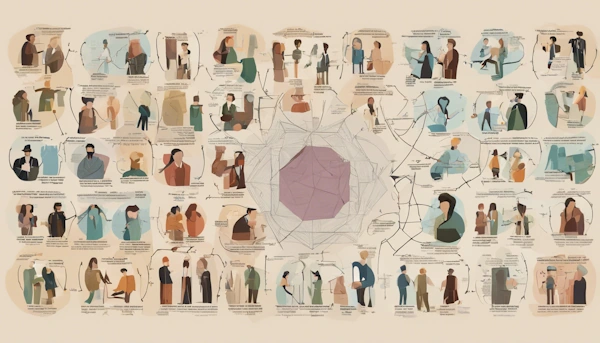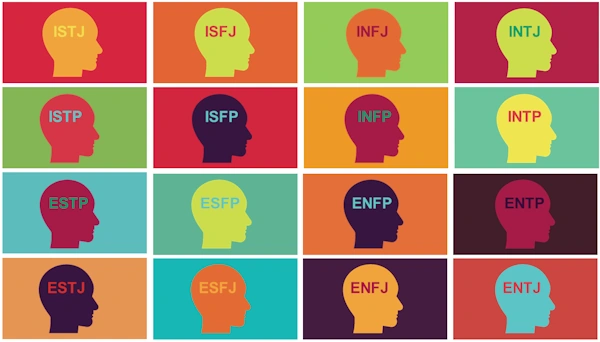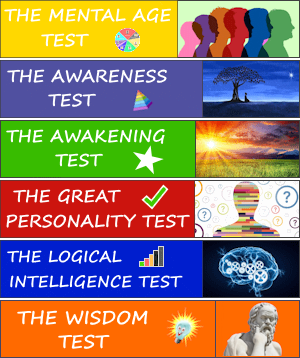In the realm of psychological assessment, the Myers-Briggs Type Indicator (MBTI) emerges as a pioneering tool, captivating the interest of both experts and the general populace alike. This assessment offers a nuanced framework for understanding human personality, delineating how individuals perceive the world and make decisions. The importance of the Myers-Briggs personality test lies not only in its application in personal development and team dynamics but also in its potential to foster greater self-awareness and interpersonal understanding. Its widespread adoption underscores its significance across various domains, from career counseling to educational settings, making it a subject of both intrigue and utility.

This comprehensive guide aims to dissect the intricacies of the Myers-Briggs Type Indicator, offering an in-depth examination of its four preference pairs and how these underpin the 16 distinct personality types it identifies. Subsequent sections will explore the manifold applications of the MBTI test, illuminating its benefits for personal and professional growth, while also addressing the critiques it has drawn over the years. The objective of this article is to provide a balanced perspective on the merits and limitations of the Myers-Briggs Type Indicator (MBTI) and its alternatives. It aims to guide readers through the complexities of this widely utilized personality assessment framework.
Overview of the Myers-Briggs Personality Test
History and Origin
The Myers-Briggs Type Indicator (MBTI) was conceived by Katharine Cook Briggs and her daughter Isabel Briggs Myers. Inspired by Carl Jung’s theory of psychological types, outlined in his 1921 work Psychological Types, Briggs and Myers set out to create a tool that would facilitate the accessibility of Jung’s complex theories to a broader audience. Their research commenced in the early 20th century, driven by a fascination with human behavior and a commitment to facilitating individuals’ understanding of themselves and others.
Katharine Cook Briggs, initially intrigued by the personality differences she observed in her future son-in-law, conducted extensive research into the subject of temperament and personality. Her research coincided with the translation of Jung’s work into English, which further shaped her ideas and methodologies. Together with her daughter, they developed the MBTI during a period of global unrest, when they believed that increased understanding among people could lead to more effective collaboration and less global strife.
The MBTI was first published in 1962 and has since undergone regular enhancements to ensure its continued relevance and accuracy across different cultures and demographics. The ongoing development of the Myers-Briggs Type Indicator (MBTI) is overseen by The Myers-Briggs Company, which ensures that the assessment remains a valuable tool for personal and professional development.
Main Features of the Test
The Myers–Briggs Type Indicator (MBTI) is an introspective self-report questionnaire designed to identify a person’s personality type, strengths, and preferences. The assessment categorizes psychological preferences in four dimensions: The four dimensions of the Myers–Briggs Type Indicator (MBTI) are introversion versus extraversion, sensing versus intuition, thinking versus feeling, and judging versus perceiving. Each dimension represents a dichotomous choice that contributes to the respondent’s personality type, resulting in one of 16 distinct types, such as INFP or ESTJ.
These types are derived from Jung’s assertion that humans experience the world using four principal psychological functions—thinking, feeling, sensation, and intuition—with one of these four functions being dominant most of the time. The Myers–Briggs Type Indicator (MBTI) extends Jung’s typology by assigning a directional attitude (either introverted or extraverted) to each psychological function, thereby providing a more nuanced character analysis.
The MBTI’s distinctive feature is its emphasis on the dynamic interplay between these functions within a given personality type. This interaction, known as type dynamics, exerts a significant influence on an individual’s behavior and decision-making processes. An understanding of these dynamics provides deeper insights into one’s character, which in turn promotes better self-awareness and more effective interpersonal relationships.
The MBTI has achieved a significant degree of global recognition and cultural adaptability, becoming the most widely utilized personality assessment tool worldwide. Millions of individuals engage with the test on an annual basis, seeking insights into their personality types. This extensive utilization serves to illustrate the instrument’s efficacy in a multitude of applications, including career planning and educational guidance, among others.
The Four Myers-Briggs Preference Pairs
Extraversion vs. Introversion
This dichotomy explores where individuals direct their energy and attention. Those who exhibit an inclination towards extraversion are energized by interactions in the external world, particularly those involving people and activities. Those who exhibit an extraverted personality type tend to thrive on external stimuli and are often perceived as outgoing and sociable. In contrast, those who exhibit an inclination towards introversion derive a sense of stimulation from engaging in activities that facilitate reflection and contemplation. They typically require periods of solitude to recharge and are more reserved in their interactions with the external environment.
Sensing vs. Intuition
The Sensing vs. Intuition dichotomy indicates how individuals prefer to gather information. Those who are oriented towards sensation are inclined to focus on the immediate, tangible data that can be accessed through their senses. They prioritize the practical applications of knowledge and often rely on past experiences to inform their decision-making. Conversely, those with a preference for Intuition are more attuned to patterns and possibilities. They are drawn to abstract theories and are adept at seeing the big picture, often focusing on future possibilities rather than immediate realities.
Thinking vs. Feeling
The dichotomy between thinking and feeling represents the fundamental basis of decision-making processes. Those with a preference for thinking make decisions based on logical analysis and objective principles. Those with a preference for truth and fairness often adopt a detached, impersonal approach to decision-making. In contrast, those with a preference for Feeling base their decisions on personal values and the emotional impact on themselves and others. They prioritize harmony and empathy, often considering the human element in their decision-making process.
Judging vs. Perceiving
The final dichotomy, Judging vs. Perceiving, pertains to the manner in which individuals interact with the external world. Those who prefer Judging value structure and order. Those who prefer Judging enjoy making decisions, organizing their lives, and having matters settled. They adopt a planned and orderly approach to life, seeking closure. In contrast, those who prefer perceiving are more adaptable and open to new information and experiences. Those who prefer Judging tend to enjoy living in a flexible and spontaneous manner, and they often prefer to keep their options open. They may delay decisions in order to gather more information.

By understanding these four preference pairs, individuals can gain deeper insights into their character, enhancing self-awareness and improving interactions in both personal and professional contexts.
Applications of the Myers-Briggs Personality Test
The Myers-Briggs Type Indicator (MBTI), with its exhaustive profiling, serves a multitude of purposes across a range of domains. These applications not only facilitate personal understanding but also enhance dynamics in professional environments.
Personal Growth
The Myers-Briggs Type Indicator (MBTI) plays a pivotal role in fostering an individual’s self-awareness. By understanding their character type, individuals are able to identify their strengths and areas for improvement. This awareness facilitates personal development, enabling individuals to pursue suitable growth strategies that resonate with their inherent dispositions. The Myers-Briggs Type Indicator (MBTI) is a valuable tool for identifying how different personality types respond to stress and conflict. By understanding their personality type, individuals can identify their strengths and areas for improvement. This awareness facilitates personal development, enabling individuals to pursue healthier coping mechanisms and interpersonal interactions.
Career and Education
In educational settings and career planning, the Myers–Briggs Type Indicator (MBTI) is a highly valuable tool. Students and professionals gain insights into their preferred learning styles and work environments, which can inform their educational choices and career paths. For example, an individual identified as INTJ may flourish in careers that necessitate analytical and independent thinking, leading them to pursue fields such as engineering or research. Educational institutions and career counselors frequently employ MBTI results to assist individuals in aligning their career trajectories with their personality types, thereby enhancing job satisfaction and performance.
Team Development
The application of the Myers-Briggs Type Indicator (MBTI) in team settings cannot be overstated. An understanding of the diverse personality types within a team can facilitate more effective collaboration and communication. Managers and team leaders utilize MBTI assessments to ensure a balanced team, combining various personality types that complement each other’s strengths and weaknesses. This strategic composition optimizes team efficiency and harmony, as team members recognize and leverage the diverse perspectives and skills brought by each character type.
Leadership Development
Another significant application of the Myers-Briggs Type Indicator (MBTI) is in the field of leadership development. Both emerging and established leaders may benefit from an understanding of their leadership style, which is influenced by their Myers-Briggs Type Indicator (MBTI) type. For instance, an ENTJ personality type is likely to be assertive and strategic, frequently excelling in decision-making and setting clear directions. By recognizing their natural leadership style, leaders can work on enhancing their effectiveness and adapt their approaches to various situations. This fosters a supportive and motivating environment for their teams.
The Myers-Briggs Personality Test is a valuable tool for personal and professional development, as well as enhancing interpersonal relationships and team dynamics across different contexts.
Benefits and Criticisms of the MBTI
Advantages
The Myers-Briggs Type Indicator (MBTI) is renowned for its capacity to cultivate enhanced self-awareness and interpersonal understanding. As a tool based on the theories of Carl Jung, it facilitates a more profound understanding of personal behaviors and preferences, which in turn contributes to personal and professional development. Those who are able to comprehend their MBTI type frequently undergo personal growth as a result of identifying their strengths and areas for improvement. This awareness enables the development of strategies that align with an individual’s inherent characteristics.
In professional settings, the Myers-Briggs Type Indicator (MBTI) is employed to enhance team dynamics and facilitate leadership development. By grasping the various personality types within a team, leaders can cultivate a harmonious environment that capitalizes on individual strengths. This not only enhances productivity but also fosters a culture of mutual respect and understanding. Moreover, the MBTI’s role in career planning cannot be overstated. The MBTI assists individuals in selecting career paths that align with their personality types, which may enhance job satisfaction and performance.
Common Criticisms
Despite its pervasive usage, the Myers–Briggs Type Indicator (MBTI) is the subject of numerous critiques. One significant criticism is that the MBTI relies on dichotomous choices, which may oversimplify the complex spectrum of human character. Those who critique the MBTI argue that the dichotomous preference pairs it employs do not adequately capture the nuanced gradations in traits that most individuals exhibit. Moreover, the test’s reliability has been called into question. Some studies have indicated that test results can vary significantly over time, suggesting potential inconsistencies in the determination of personality types.
Another significant concern is the application of the Myers–Briggs Type Indicator (MBTI) in professional settings, particularly in hiring and job performance evaluations. Those who oppose the use of the MBTI in employment decisions argue that it could lead to discrimination and that it does not accurately reflect an individual’s capabilities or potential for success in a role. Moreover, the scientific validity of the Myers–Briggs Type Indicator (MBTI) is often called into question. Some psychologists contend that the empirical evidence supporting the theoretical foundations of the Myers–Briggs Type Indicator (MBTI) is insufficient, likening it to pseudoscience.
Notwithstanding these critiques, the Myers–Briggs Type Indicator (MBTI) persists as a prevalent instrument for elucidating individual personality variations. It is of the utmost importance, however, that users apply the results of the MBTI in a thoughtful and ethical manner, recognizing the limitations of the tool while appreciating the insights it can provide.
Our Better Alternatives
The real limitation of personality tests based on the Myers-Briggs theory, and in general of all those tests that try to fit humans within well-defined categories, lies in oversimplification. The human mind is complex, and a single psychological survey instrument, no matter how elaborate, can never provide an exhaustive picture of the individual using it.
This is the exact reason why we, at The Spiritual Seek, decided to create several personality tests instead of relying on a single questionnaire. To please those who love the Myers-Briggs Indicator approach, we developed our own version of that instrument, giving it the name Great Personality Test and modernizing it through the introduction of the self-calibrating function.

Aware of the fact that our assessment, although one of the best of its kind, cannot satisfy the most curious and introspective people, we have therefore devised other very special and exclusive personality tests. We refer to the Awarenes Test, the Awakening Test and the Mental Age Test. For the more demanding, there is also the Logical Intelligence Test. We recommend that you try them all, because only then can you get a sufficiently detailed account not only of your personality, but also of the level of awareness behind it.
Human beings are conscious creatures; this means that beyond their concrete actions there is the whole part relating to inner processing to be investigated and understood. A true psychological investigation cannot stop at measuring a person’s actions, but must necessarily investigate the thoughts, beliefs and kind of consciousness that drive a person to act in a particular way. This is exactly what our tests attempt to do.
Conclusion
Throughout this guide, we have navigated the depths of the Myers-Briggs Type Indicator, unraveling its importance and utility in enhancing self-awareness and facilitating both personal and professional development. The exploration revealed the dual nature of the MBTI, illuminating it as a dynamic tool for understanding human personality through various lenses. From its inception, rooted in the pioneering work of Katharine Cook Briggs and Isabel Briggs Myers, to its application in contemporary settings, the MBTI has consistently offered valuable insights into the interplay of personality preferences that influence how individuals perceive the world and make decisions.
The discourse also shed light on the critical views that challenge the MBTI, prompting a more nuanced understanding of its capabilities and limitations. In embracing the complexities and critiques associated with the MBTI, we encourage a balanced perspective, recognizing its profound impact on personal growth, team dynamics, and leadership development, while also acknowledging the need for thoughtful and ethical application. As we conclude, the journey through the Myers-Briggs Type Indicator highlights an enduring quest for understanding the multifaceted nature of human personality, advocating for continuous exploration and adaptation in the ever-evolving landscape of psychological assessment.
As a very last thing, a gift for you! The MBTI test in a super quick version reworked by the staff of The Spiritual Seek and provided free of charge to our users.
MBTI 16 PERSONALITY TYPES TEST – quick version
FAQs
1. Which Myers-Briggs personality type is the least common?
The INFJ personality type is considered the rarest among the Myers-Briggs Type Indicator (MBTI) personalities, comprising only about 1% to 3% of the U.S. population. This rarity is often attributed to their complex nature, embodying numerous contradictions.
2. Which Myers-Briggs personality type typically experiences the least happiness?
According to studies, including findings from the third edition of the MBTI® Manual, INFPs tend to report the lowest levels of happiness and life satisfaction. Additionally, this type is often dissatisfied with their marital and intimate relationships, ranking second highest in dissatisfaction.
3. What is the professional view of the Myers-Briggs Type Indicator among psychologists?
While the Myers-Briggs Type Indicator has limitations and is not universally accepted as a scientifically valid personality assessment, many psychologists view it as a useful tool for self-reflection. It can initiate valuable discussions about personality perceptions, human behavior variations, and interpersonal relationships.
4. Which Myers-Briggs personality type is considered the most difficult to identify?
The INFJ type is often seen as the most challenging to accurately determine using the MBTI. INFJs are known as chameleons; they have the innate ability to blend into their surroundings and often adopt the characteristics of those around them, making it hard to pinpoint their true personality type.
MINI SELF-EVALUATION TEST: ARE YOU A CURIOUS PERSON?
Read the sentences below and select the ones you agree with and that you think make the most sense.
Count the number of boxes checked and read the corresponding profile.
0: Curiosity is not your thing
1-2: You are a scarcely curious person
3-4: You are an average curious person
5-6: You are a really curious person
MINI SELF-ASSESSMENT TEST: ARE YOU A CONFORMIST AND HOMOLOGATED PERSON?
Read the sentences below and select the ones you agree with and that you think make the most sense.
Count the number of boxes checked and read the corresponding profile.
0: You are not conformist at all
1-2: You are hardly conformist
3-4: You are quite conformist
5-6: You are totally conformist

